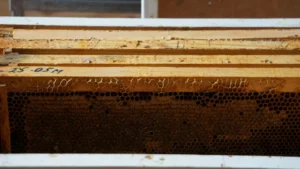Table of Contents
Manuka honey has gained popularity in recent years for its unique medicinal properties and therapeutic benefits. In this article, we will explore the use of manuka honey for cuts and wounds, its healing properties, and how to effectively use it for optimal results.
What is Manuka Honey?
Manuka honey is a special type of honey that is produced by bees that feed on the flowers of the Manuka bush (Leptospermum scoparium), which is native to New Zealand. This honey is known for its dark color, thick consistency, and distinctive flavor. What sets manuka honey apart from other types of honey is its high concentration of methylglyoxal (MGO) and dihydroxyacetone, which are unique compounds with powerful antibacterial properties.
The Healing Properties of Manuka Honey
Manuka honey has been used for centuries as a natural remedy for various ailments, including cuts and wounds. It has potent antibacterial, antiviral, and anti-inflammatory properties that can help prevent infection, reduce inflammation, and promote healing.
Antibacterial Properties
One of the key benefits of manuka honey for cuts is its ability to kill harmful bacteria that can cause infection. The high levels of MGO in manuka honey create an acidic environment that inhibits the growth of bacteria. This makes it an effective natural alternative to antibiotics for treating minor wounds and preventing bacterial infections.
Anti-inflammatory Properties
Inflammation is a natural response of the body to injury, but excessive inflammation can delay the healing process. Manuka honey has anti-inflammatory properties that can help reduce swelling, redness, and pain associated with cuts and wounds. It can also promote the formation of new blood vessels and tissue regeneration, which are essential for wound healing.
Moisture Retention
Keeping a wound moist is crucial for optimal healing. Manuka honey has hygroscopic properties, which means it can absorb moisture from the air and retain it in the wound. This helps create an ideal environment for healing by preventing the wound from drying out and promoting the growth of new skin cells.
How to Use Manuka Honey for Cuts
Using manuka honey for cuts is simple and straightforward. Here’s a step-by-step guide on how to effectively use it for optimal results:
-
Clean the Wound: Before applying manuka honey, make sure to thoroughly clean the wound with mild soap and water. This will help remove any dirt, debris, or bacteria from the wound, reducing the risk of infection.
-
Apply Manuka Honey: Using a clean cotton swab or sterile gauze pad, apply a generous amount of manuka honey directly to the wound. Make sure to cover the entire wound with a thick layer of honey.
-
Cover the Wound: After applying the honey, cover the wound with a sterile dressing or bandage to protect it from dirt and bacteria. This will also help keep the honey in place and prevent it from sticking to clothing or bedding.
-
Change the Dressing: Depending on the severity of the wound, you may need to change the dressing and reapply manuka honey once or twice a day. Make sure to clean the wound thoroughly before each application.
Precautions and Considerations
While manuka honey is generally safe to use for cuts and wounds, there are a few precautions and considerations to keep in mind:
-
Allergies: Some individuals may be allergic to honey or bee products. If you have a known allergy to honey, bee stings, or bee pollen, it’s best to avoid using manuka honey for cuts.
-
Quality and Authenticity: Manuka honey is available in various grades and potency levels. To ensure you’re getting a high-quality and authentic product, look for a reputable brand that carries the Unique Manuka Factor (UMF) certification. This certification guarantees that the honey meets specific quality standards and contains the beneficial compounds responsible for its healing properties.
-
Deep or Severe Wounds: While manuka honey can be effective for minor cuts and wounds, it may not be suitable for deep or severe wounds that require medical attention. If you have a deep or severe wound, it’s best to consult a healthcare professional for proper treatment and care.
-
Moderation: While manuka honey has numerous health benefits, it’s important to use it in moderation. Like any sweetener, honey is high in calories and can contribute to weight gain if consumed excessively.
Conclusion
Manuka honey is a natural remedy with potent healing properties, making it an excellent choice for treating cuts and wounds. Its antibacterial, anti-inflammatory, and moisture-retaining properties can help prevent infection, reduce inflammation, and promote optimal wound healing. By following the proper application and precautions, manuka honey can be a safe and effective natural remedy for cuts and wounds.



